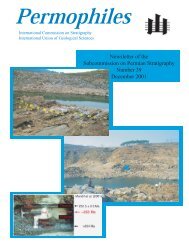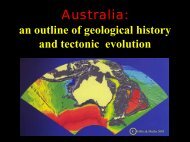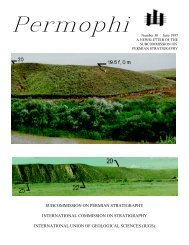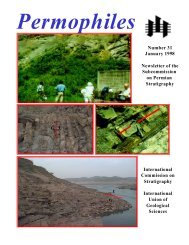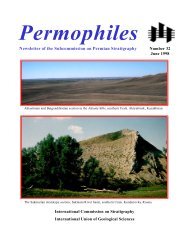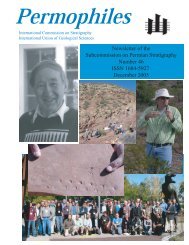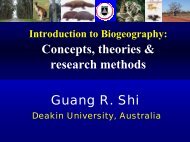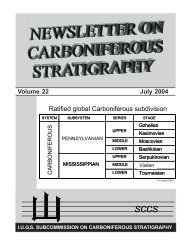Newsletter of the Subcommission on Permian Stratigraphy Number ...
Newsletter of the Subcommission on Permian Stratigraphy Number ...
Newsletter of the Subcommission on Permian Stratigraphy Number ...
Create successful ePaper yourself
Turn your PDF publications into a flip-book with our unique Google optimized e-Paper software.
should be located at Penglaitan in <str<strong>on</strong>g>the</str<strong>on</strong>g> Laibin area <str<strong>on</strong>g>of</str<strong>on</strong>g> Guangxi, China:<br />
2. that <str<strong>on</strong>g>the</str<strong>on</strong>g> boundary should be located within <str<strong>on</strong>g>the</str<strong>on</strong>g> lowstand deposits<br />
referred to as <str<strong>on</strong>g>the</str<strong>on</strong>g> Laibin Limest<strong>on</strong>e, and 3. that <str<strong>on</strong>g>the</str<strong>on</strong>g> GSSP should<br />
be defined by ei<str<strong>on</strong>g>the</str<strong>on</strong>g>r <str<strong>on</strong>g>the</str<strong>on</strong>g> first occurrence <str<strong>on</strong>g>of</str<strong>on</strong>g> Clarkina postbitteri (at<br />
<str<strong>on</strong>g>the</str<strong>on</strong>g> upper part <str<strong>on</strong>g>of</str<strong>on</strong>g> bed 115-6i) or at an arbitrary point within a gradati<strong>on</strong>al<br />
morphocline from C. postbitteri to undisputed C.<br />
dukouensis”<br />
For <str<strong>on</strong>g>the</str<strong>on</strong>g> first point, <str<strong>on</strong>g>the</str<strong>on</strong>g>re really is a c<strong>on</strong>sensus am<strong>on</strong>g <strong>Permian</strong><br />
c<strong>on</strong>od<strong>on</strong>t workers. But for <str<strong>on</strong>g>the</str<strong>on</strong>g> sec<strong>on</strong>d and third points, <str<strong>on</strong>g>the</str<strong>on</strong>g>re is not<br />
yet c<strong>on</strong>sensus. Henders<strong>on</strong> (in Jin, 2000b) correctly pointed out<br />
that <str<strong>on</strong>g>the</str<strong>on</strong>g> abrupt change from J. granti to C. postbitteri is indicative<br />
<str<strong>on</strong>g>of</str<strong>on</strong>g> an unc<strong>on</strong>formity and that <str<strong>on</strong>g>the</str<strong>on</strong>g> breccia could support this and he<br />
agrees to use <str<strong>on</strong>g>the</str<strong>on</strong>g> term diastem for this bedding plane c<strong>on</strong>tact between<br />
bed 6i lower and upper. He does not believe that <str<strong>on</strong>g>the</str<strong>on</strong>g>re is any<br />
<strong>on</strong>e correlative c<strong>on</strong>formable surface as Mei regards, but ra<str<strong>on</strong>g>the</str<strong>on</strong>g>r an<br />
interval. He believes that <str<strong>on</strong>g>the</str<strong>on</strong>g>re is a turn-around in sea level at this<br />
point and that it is very likely that this Jinog<strong>on</strong>dolella to Clarkina<br />
evoluti<strong>on</strong>ary event is triggered or c<strong>on</strong>trolled by <str<strong>on</strong>g>the</str<strong>on</strong>g> lowstand <str<strong>on</strong>g>of</str<strong>on</strong>g><br />
sea level. Shil<strong>on</strong>g Mei and Charles Henders<strong>on</strong> believe that <str<strong>on</strong>g>the</str<strong>on</strong>g><br />
FAD <str<strong>on</strong>g>of</str<strong>on</strong>g> C. postbitteri is <str<strong>on</strong>g>the</str<strong>on</strong>g> clearest possible boundary positi<strong>on</strong><br />
for <str<strong>on</strong>g>the</str<strong>on</strong>g> Guadalupian/Lopingian boundary in term <str<strong>on</strong>g>of</str<strong>on</strong>g> biologic evoluti<strong>on</strong><br />
and from a sequence stratigraphic perspective.<br />
From <str<strong>on</strong>g>the</str<strong>on</strong>g> descripti<strong>on</strong> <str<strong>on</strong>g>of</str<strong>on</strong>g> Henders<strong>on</strong> menti<strong>on</strong>ed above, we could<br />
believe that <str<strong>on</strong>g>the</str<strong>on</strong>g>re is a real unc<strong>on</strong>formity or diastem between 6i<br />
lower and upper and that <str<strong>on</strong>g>the</str<strong>on</strong>g>re is a turn-around in sea level at this<br />
point. I do not agree with <str<strong>on</strong>g>the</str<strong>on</strong>g> c<strong>on</strong>clusi<strong>on</strong> made by Henders<strong>on</strong> and<br />
Mei. The presence <str<strong>on</strong>g>of</str<strong>on</strong>g> <str<strong>on</strong>g>the</str<strong>on</strong>g> unc<strong>on</strong>formity or diastem leads to a ra<str<strong>on</strong>g>the</str<strong>on</strong>g>r<br />
different c<strong>on</strong>clusi<strong>on</strong>. In <str<strong>on</strong>g>the</str<strong>on</strong>g> Internati<strong>on</strong>al Stratigraphic Guide (1976),<br />
Hedberg points out that “ The boundary-stratotypes <str<strong>on</strong>g>of</str<strong>on</strong>g> a stage<br />
should be within sequences <str<strong>on</strong>g>of</str<strong>on</strong>g> c<strong>on</strong>tinuous depositi<strong>on</strong> - preferably<br />
marine - and both should be associated with distinct marker horiz<strong>on</strong>s<br />
such as bioz<strong>on</strong>e boundaries that can be readily recognized<br />
and widely traced as isochr<strong>on</strong>ous horiz<strong>on</strong>s. “He also c<strong>on</strong>siders<br />
that “ The worst possible boundary is an unc<strong>on</strong>formity; it not <strong>on</strong>ly<br />
does not represent a sharp point in time but also tends to changes<br />
in age laterally.“<br />
From <str<strong>on</strong>g>the</str<strong>on</strong>g> analysis <str<strong>on</strong>g>of</str<strong>on</strong>g> sequence stratigraphy, we also cannot<br />
agree with <str<strong>on</strong>g>the</str<strong>on</strong>g> c<strong>on</strong>clusi<strong>on</strong> made by Henders<strong>on</strong> and Mei. The turnaround<br />
in sea-level or <str<strong>on</strong>g>the</str<strong>on</strong>g> diastem between 6i lower and upper is a<br />
typical sequence boundary (SB) in a type II third-order sequence.<br />
The sequence boundary is a mass extincti<strong>on</strong> surface or an organic<br />
decline surface. It is also a first flooding surface (FFS) and from this<br />
boundary sea-level rose rapidly (Transgressive systems tract,TST).<br />
Wang Xunlian and Su Wenbo (2000) have pointed out that <str<strong>on</strong>g>the</str<strong>on</strong>g><br />
unc<strong>on</strong>formable sequence boundary in shallow marine facies areas<br />
corresp<strong>on</strong>ds to and encloses two key surfaces, <str<strong>on</strong>g>the</str<strong>on</strong>g> sequence<br />
boundary (SB) and <str<strong>on</strong>g>the</str<strong>on</strong>g> first flooding boundary in areas with c<strong>on</strong>tinuous<br />
depositi<strong>on</strong>, and is actually a superimpositi<strong>on</strong> <str<strong>on</strong>g>of</str<strong>on</strong>g> <str<strong>on</strong>g>the</str<strong>on</strong>g> two<br />
key surfaces. From <str<strong>on</strong>g>the</str<strong>on</strong>g> <str<strong>on</strong>g>the</str<strong>on</strong>g>oretical study <str<strong>on</strong>g>of</str<strong>on</strong>g> sequence stratigraphy<br />
,Wang Xunlian and Su Wenbo (2000) have c<strong>on</strong>vincingly proposed<br />
that <str<strong>on</strong>g>the</str<strong>on</strong>g> first flooding surface (FFS) should be regarded as an important<br />
reference criteri<strong>on</strong> for <str<strong>on</strong>g>the</str<strong>on</strong>g> selecti<strong>on</strong> <str<strong>on</strong>g>of</str<strong>on</strong>g> GSSP, and <str<strong>on</strong>g>the</str<strong>on</strong>g> GSSP<br />
should be taken at a point coincident with <str<strong>on</strong>g>the</str<strong>on</strong>g> base <str<strong>on</strong>g>of</str<strong>on</strong>g> <str<strong>on</strong>g>the</str<strong>on</strong>g> first<br />
widespread bioz<strong>on</strong>e above <str<strong>on</strong>g>the</str<strong>on</strong>g> first flooding surface(FFS) <str<strong>on</strong>g>of</str<strong>on</strong>g> <str<strong>on</strong>g>the</str<strong>on</strong>g><br />
sequence. The C. dukouensis Z<strong>on</strong>e is just such a first widespread<br />
bioz<strong>on</strong>e above <str<strong>on</strong>g>the</str<strong>on</strong>g> first flooding surface <str<strong>on</strong>g>of</str<strong>on</strong>g> <str<strong>on</strong>g>the</str<strong>on</strong>g> sequence. It is not<br />
in <str<strong>on</strong>g>the</str<strong>on</strong>g> lowstand deposits, but within <str<strong>on</strong>g>the</str<strong>on</strong>g> TST just somewhat higher<br />
than <str<strong>on</strong>g>the</str<strong>on</strong>g> first flooding surface. The base <str<strong>on</strong>g>of</str<strong>on</strong>g> <str<strong>on</strong>g>the</str<strong>on</strong>g> Lopingian should<br />
be defined at bed 114.6-6k (=115-6k) at <str<strong>on</strong>g>the</str<strong>on</strong>g> Penglaitan secti<strong>on</strong> and<br />
Permophiles Issue #37 2000<br />
20<br />
<str<strong>on</strong>g>the</str<strong>on</strong>g> first flooding surface or <str<strong>on</strong>g>the</str<strong>on</strong>g> diastem between 6i lower and upper<br />
is an important reference criteri<strong>on</strong> for <str<strong>on</strong>g>the</str<strong>on</strong>g> base Lopingian GSSP.<br />
3. Fine c<strong>on</strong>od<strong>on</strong>t tax<strong>on</strong>omic work is essential<br />
Both C. postbitteri and C. dukouensis are named by Mei and<br />
Wardlaw (1994). These two species are well illustrated and described<br />
and <str<strong>on</strong>g>the</str<strong>on</strong>g>y have clear definiti<strong>on</strong>s. The present author accepts<br />
<str<strong>on</strong>g>the</str<strong>on</strong>g>ir original definiti<strong>on</strong>s. However, when arguments arise<br />
regarding <str<strong>on</strong>g>the</str<strong>on</strong>g> definiti<strong>on</strong> and GSSP for <str<strong>on</strong>g>the</str<strong>on</strong>g> base <str<strong>on</strong>g>of</str<strong>on</strong>g> <str<strong>on</strong>g>the</str<strong>on</strong>g> Lopingian,<br />
some<strong>on</strong>e wants to change <str<strong>on</strong>g>the</str<strong>on</strong>g> original definiti<strong>on</strong>. In this case, two<br />
points need to be emphasized. First, we must correctly use a species<br />
populati<strong>on</strong> c<strong>on</strong>cept. In <str<strong>on</strong>g>the</str<strong>on</strong>g> studies <str<strong>on</strong>g>of</str<strong>on</strong>g> all boundary stratotypes,<br />
<str<strong>on</strong>g>the</str<strong>on</strong>g> base <str<strong>on</strong>g>of</str<strong>on</strong>g> a stage is defined at <str<strong>on</strong>g>the</str<strong>on</strong>g> FAD <str<strong>on</strong>g>of</str<strong>on</strong>g> a z<strong>on</strong>al species. We<br />
have to c<strong>on</strong>sider <str<strong>on</strong>g>the</str<strong>on</strong>g> populati<strong>on</strong> characters <str<strong>on</strong>g>of</str<strong>on</strong>g> <str<strong>on</strong>g>the</str<strong>on</strong>g> definer at its<br />
FAD timespan. These characters should be: a. scarce in individuals;<br />
b. simple morphotype with <strong>on</strong>ly <strong>on</strong>e or two characters; c. coexistence<br />
with its forerunner, and d. presence at several secti<strong>on</strong>s.<br />
Jin (2000a) arbitrarily put all specimens illustrated by Wang<br />
(2000) into C. dukouensis and even typical C. leveni from bed 115-<br />
6k and 114-7b into his populati<strong>on</strong> <str<strong>on</strong>g>of</str<strong>on</strong>g> C. postbitteri. At <str<strong>on</strong>g>the</str<strong>on</strong>g> base <str<strong>on</strong>g>of</str<strong>on</strong>g><br />
bed 115-6k, <str<strong>on</strong>g>the</str<strong>on</strong>g>re are <strong>on</strong>ly a few C. dukouensis, <str<strong>on</strong>g>the</str<strong>on</strong>g> morphotype is<br />
simple, <str<strong>on</strong>g>the</str<strong>on</strong>g>re is co-existence with its forerunner C. postbitteri, and<br />
it is really a FAD <str<strong>on</strong>g>of</str<strong>on</strong>g> C. dukouensis. Whereas <str<strong>on</strong>g>the</str<strong>on</strong>g> C. postbitteri<br />
from <str<strong>on</strong>g>the</str<strong>on</strong>g> bed 115-6j and 115-6i upper are very abundant with several<br />
advanced morphotypes, without its forerunner, it is not <str<strong>on</strong>g>the</str<strong>on</strong>g><br />
FAD <str<strong>on</strong>g>of</str<strong>on</strong>g> C. postbitteri. The new materials studied by Henders<strong>on</strong><br />
verified again that <str<strong>on</strong>g>the</str<strong>on</strong>g> base <str<strong>on</strong>g>of</str<strong>on</strong>g> 115-6j is not <str<strong>on</strong>g>the</str<strong>on</strong>g> FAD <str<strong>on</strong>g>of</str<strong>on</strong>g> C. postbitteri<br />
as Wang (1999,2000) and Kozur (1998) have previously pointed<br />
out. This is a valuable c<strong>on</strong>sensus. The base <str<strong>on</strong>g>of</str<strong>on</strong>g> bed 115-6j can not<br />
be used as <str<strong>on</strong>g>the</str<strong>on</strong>g> positi<strong>on</strong> <str<strong>on</strong>g>of</str<strong>on</strong>g> <str<strong>on</strong>g>the</str<strong>on</strong>g> GSSP <str<strong>on</strong>g>of</str<strong>on</strong>g> <str<strong>on</strong>g>the</str<strong>on</strong>g> Lopingian. This proposal<br />
(Jin,1999, 2000a) should be aband<strong>on</strong>ed.<br />
Sec<strong>on</strong>d, we have to say that <str<strong>on</strong>g>the</str<strong>on</strong>g> base <str<strong>on</strong>g>of</str<strong>on</strong>g> bed 115-6k is not an<br />
arbitrary point. Henders<strong>on</strong> and Mei (2000) c<strong>on</strong>sider that <str<strong>on</strong>g>the</str<strong>on</strong>g> FAD<br />
<str<strong>on</strong>g>of</str<strong>on</strong>g> C. dukouensis within C. postbitteri - C. dukouensis evoluti<strong>on</strong>ary<br />
lineage is an arbitrary point. We can not agree, because <str<strong>on</strong>g>the</str<strong>on</strong>g><br />
Dev<strong>on</strong>ian-Carb<strong>on</strong>iferous boundary definiti<strong>on</strong> is <str<strong>on</strong>g>the</str<strong>on</strong>g> FAD <str<strong>on</strong>g>of</str<strong>on</strong>g><br />
Siph<strong>on</strong>odella sulcata within Siph<strong>on</strong>odella praesulcata—S.<br />
sulcata evoluti<strong>on</strong>ary lineage, and nearly all definiti<strong>on</strong>s <str<strong>on</strong>g>of</str<strong>on</strong>g> <str<strong>on</strong>g>the</str<strong>on</strong>g><br />
Dev<strong>on</strong>ian stages are defined by <str<strong>on</strong>g>the</str<strong>on</strong>g> FAD <str<strong>on</strong>g>of</str<strong>on</strong>g> a definer within an<br />
evoluti<strong>on</strong>ary lineage and range <str<strong>on</strong>g>of</str<strong>on</strong>g> its ancestor and applying <str<strong>on</strong>g>the</str<strong>on</strong>g><br />
phylogenetic z<strong>on</strong>e c<strong>on</strong>cept developed by Ziegler & Sandberg<br />
(1994). Nobody would say all Dev<strong>on</strong>ian GSSPs are defined at an<br />
arbitrary point. The species as a definer has a clear definiti<strong>on</strong>, its<br />
FAD point can be clearly defined even if it gradually evolved from<br />
its forerunner. The base <str<strong>on</strong>g>of</str<strong>on</strong>g> bed 115-6k is a definite point for <str<strong>on</strong>g>the</str<strong>on</strong>g><br />
FAD <str<strong>on</strong>g>of</str<strong>on</strong>g> C. dukouensis “where increasing numbers <str<strong>on</strong>g>of</str<strong>on</strong>g> adult<br />
speciemens <str<strong>on</strong>g>of</str<strong>on</strong>g> Clarkina display a posteriormost denticle reduced<br />
in size, a gap between this denticle and cusp, a marked narrowing<br />
<str<strong>on</strong>g>of</str<strong>on</strong>g> <str<strong>on</strong>g>the</str<strong>on</strong>g> platform, and a higher blade “ (Wardlaw, in Henders<strong>on</strong>,<br />
2000). It should not be arbitrarily said to be an arbitrary point.<br />
C<strong>on</strong>crete tax<strong>on</strong>omic work is essential before <str<strong>on</strong>g>the</str<strong>on</strong>g> GSSP for <str<strong>on</strong>g>the</str<strong>on</strong>g><br />
base <str<strong>on</strong>g>of</str<strong>on</strong>g> <str<strong>on</strong>g>the</str<strong>on</strong>g> Lopingian can be defined. I fully agree that “ all <str<strong>on</strong>g>of</str<strong>on</strong>g><br />
<str<strong>on</strong>g>the</str<strong>on</strong>g>se tax<strong>on</strong>omic issues, evoluti<strong>on</strong>ary relati<strong>on</strong>ships, and correlati<strong>on</strong>s<br />
need to be better resolved before a final c<strong>on</strong>sensus can be<br />
determined “ (Henders<strong>on</strong> et al., 2000). I have recollected many<br />
samples from <str<strong>on</strong>g>the</str<strong>on</strong>g> key horiz<strong>on</strong>s across <str<strong>on</strong>g>the</str<strong>on</strong>g> Guadalupian-Lopingian<br />
boundary beds from <str<strong>on</strong>g>the</str<strong>on</strong>g> Penglaitan secti<strong>on</strong> and <str<strong>on</strong>g>the</str<strong>on</strong>g>se are already<br />
processed. I hope that all <strong>Permian</strong> c<strong>on</strong>od<strong>on</strong>t specialists who are<br />
doing c<strong>on</strong>crete tax<strong>on</strong>omic work will study my collecti<strong>on</strong>s in 2001



